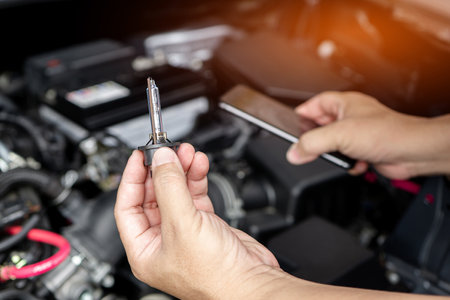1. Understanding Your Car Battery
Your car battery is the heart of your vehicle’s electrical system. It provides the power needed to start the engine and supports various electrical components. Understanding the different types of car batteries and how they work can help you choose the right one for your vehicle and maintain it properly.
Types of Car Batteries
Not all car batteries are the same. There are several types, each with unique features. The most common types include:
| Battery Type | Features | Expected Lifespan |
|---|---|---|
| Lead-Acid Battery | Affordable, reliable, requires maintenance | 3-5 years |
| Absorbent Glass Mat (AGM) Battery | More durable, maintenance-free, better performance | 4-7 years |
| Gel Battery | Leak-proof, handles deep discharge well | 4-6 years |
| Lithium-Ion Battery | Lightweight, long-lasting, fast charging | 8-10 years |
How Car Batteries Work
Car batteries store chemical energy and convert it into electrical energy when needed. Here’s a simple breakdown of how they function:
1. Powering Up the Engine
When you turn the key or press the start button, the battery sends an electrical current to the starter motor, which cranks the engine.
2. Supplying Electricity
The battery provides power to essential components like headlights, radio, air conditioning, and power windows.
3. Recharging While Driving
As your car runs, the alternator recharges the battery, ensuring it has enough power for the next engine start.
Typical Battery Lifespan
Most car batteries last between 3 to 7 years, depending on the type, climate, and maintenance. Regularly checking your battery’s condition and following proper maintenance can help extend its life.
2. Signs of a Failing Battery
Recognizing the early warning signs of a failing car battery can save you from unexpected breakdowns. Here are the most common indicators that your battery may be on its way out:
Slow Engine Crank
When you start your vehicle, the engine should crank smoothly. If you notice that it takes longer than usual or the cranking sounds sluggish, your battery might be struggling to provide enough power.
Dim Headlights
Weak or flickering headlights are a major sign that your battery isn’t supplying enough power. If your lights appear dimmer than usual, especially when idling, the battery might be losing charge.
Dashboard Warning Lights
Many modern vehicles have dashboard indicators that alert you to battery issues. Look for a battery-shaped warning light, or a check engine light, as they might signal charging system problems.
Signs to Watch For
| Warning Sign | Possible Cause |
|---|---|
| Slow engine crank | Battery is losing charge or failing |
| Dim or flickering headlights | Battery is not supplying enough power |
| Dashboard battery warning light | Issues with battery or charging system |
| Clicking sound when turning the key | Not enough power to start the engine |
| Swollen or leaking battery case | Battery is overheating or damaged |
What to Do Next?
If you notice any of these warning signs, it’s a good idea to have your battery tested by a professional. Many auto parts stores offer free battery testing, which can help determine if you need a replacement.
![]()
3. Essential Battery Maintenance Tips
Regular battery maintenance is key to ensuring long-lasting performance and preventing unexpected breakdowns. By following these essential steps, you can keep your car battery in top condition.
Cleaning the Battery Terminals
Corrosion on battery terminals can interfere with the electrical connection and reduce battery efficiency. To clean the terminals:
- Turn off the car and wear protective gloves.
- Mix baking soda with water and use a brush to scrub off corrosion.
- Rinse with clean water and dry thoroughly.
- Apply petroleum jelly or a battery terminal protector to prevent future corrosion.
Checking Battery Fluid Levels
Many traditional lead-acid batteries require regular fluid level checks to function properly. Follow these steps:
- Open the battery caps (if applicable).
- Ensure the electrolyte level covers the internal plates.
- If low, top off with distilled water—never use tap water.
- Secure the caps and wipe off any excess fluid.
Preventing Battery Corrosion
Corrosion buildup can lead to poor performance and even battery failure. Here are some ways to prevent it:
| Prevention Method | How It Helps |
|---|---|
| Applying anti-corrosion spray | Protects terminals from buildup |
| Regularly inspecting battery terminals | Allows early detection of corrosion |
| Driving regularly | Keeps the battery charged and prevents acid stratification |
Following a Routine Maintenance Schedule
Car battery maintenance should be a regular part of your vehicle care routine. Checking and cleaning the battery every few months will help extend its lifespan and ensure reliable performance.
4. How to Extend Your Battery Life
Taking care of your car battery doesnt have to be complicated. By following a few simple best practices, you can extend its lifespan and avoid unexpected breakdowns. Here are some essential tips to keep your battery performing at its best.
Avoid Frequent Short Trips
Short trips can prevent your battery from fully charging. Starting your car requires a significant amount of power, and if you only drive for a few minutes, the alternator doesnt have enough time to recharge the battery. To keep your battery healthy, try to take longer drives occasionally or use a battery maintainer if your car sits idle for extended periods.
Keep Battery Connections Tight and Clean
Loose or corroded battery terminals can lead to weak connections, making it harder for your battery to deliver power to your vehicle. To maintain a good connection:
- Check the terminals regularly.
- Use a wrench to tighten any loose connections.
- Clean off any corrosion with a mix of baking soda and water.
- Apply a thin layer of petroleum jelly to prevent future corrosion.
Ensure Proper Charging
Your cars charging system plays a crucial role in battery health. An undercharging or overcharging alternator can shorten your battery’s lifespan. To ensure proper charging, keep these points in mind:
| Charging Tip | Why It’s Important |
|---|---|
| Check the alternator voltage | Too much or too little voltage can damage the battery. |
| Avoid excessive electrical drain | Leaving lights or accessories on when the engine is off can drain the battery. |
| Use a maintainer for long storage | A battery maintainer helps keep the charge stable when your car isn’t used often. |
By following these simple steps, you can help maximize the life of your car battery and ensure reliable performance when you need it most!
5. Five: Jump-Starting a Dead Battery Safely
A dead battery can leave you stranded, but knowing how to safely jump-start your car can get you back on the road quickly. Follow this step-by-step guide to safely jump-start your vehicle using jumper cables or a portable battery pack.
What You’ll Need
- A set of jumper cables
- A functional vehicle with a charged battery (if using another car)
- A portable battery pack (if available)
- Safety gloves and goggles (optional but recommended)
Step-by-Step Guide to Using Jumper Cables
- Position the vehicles: Park both cars close enough so the jumper cables can reach but do not let them touch.
- Turn off both cars: Ensure both vehicles are in park or neutral and have the ignition turned off.
- Attach the cables:
Step Action 1 Connect the red (positive) clamp to the dead battery’s positive terminal. 2 Connect the other red (positive) clamp to the working battery’s positive terminal. 3 Connect the black (negative) clamp to the working battery’s negative terminal. 4 Attach the last black (negative) clamp to an unpainted metal surface on the dead car (not the battery). - Start the working car: Let it run for a few minutes to charge the dead battery.
- Start the dead car: Try turning the key. If it doesn’t start, wait a few more minutes before trying again.
- Remove the cables in reverse order:
- Remove the black (negative) clamp from the previously dead car.
- Remove the black (negative) clamp from the working car.
- Remove the red (positive) clamp from the working car.
- Remove the red (positive) clamp from the previously dead car.
- Let the car run: Keep the previously dead car running for at least 15-20 minutes to recharge the battery.
Using a Portable Battery Pack
- Turn off the car and locate the battery terminals.
- Connect the red (positive) clamp to the battery’s positive terminal.
- Connect the black (negative) clamp to an unpainted metal surface (not the battery).
- Turn on the battery pack and wait a few moments.
- Start the car; if it doesnt start, wait a minute and try again.
- Once the car is running, turn off the battery pack and disconnect the clamps in reverse order.
Safety Tips
- Never allow clamps to touch each other while connected to a power source.
- Ensure the jumper cables are in good condition before use.
- Use a portable battery pack if no other vehicle is available.
- If jump-starting fails multiple times, your battery may need to be replaced.
By following these steps, you can safely jump-start your car and avoid unnecessary towing expenses. Keeping a jumper cable or a portable battery pack in your vehicle can be a lifesaver in emergencies.


